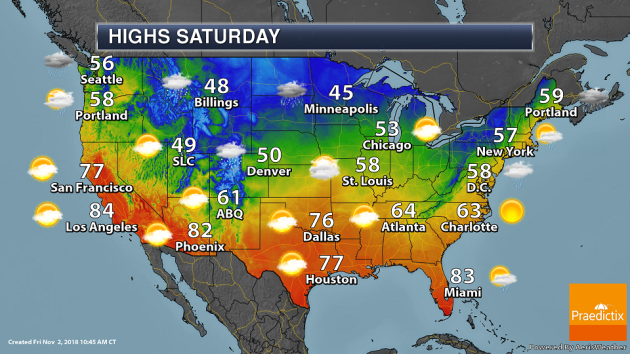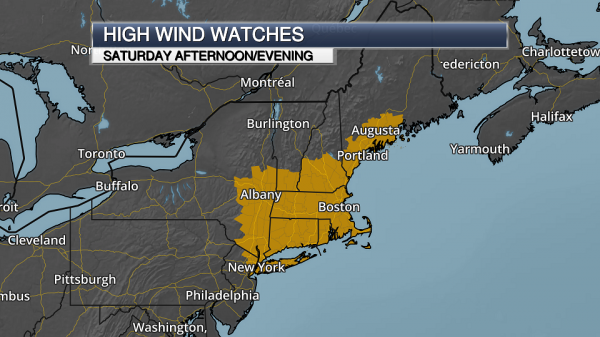National Weather Forecast


As a cold front finally start to clear the East Coast, showers and a few storms will still be possible for areas in the Northeast and southern Florida. A low-pressure area pushing out into the central U.S. will bring rain and snow to parts of the central and northern Plains into the western Great Lakes. A new system pushing into the Pacific Northwest will bring rain and higher elevation snow to the region.

Rainfall amounts of 1-3″ will be possible near the Northeast coast from Friday into Saturday as a cold front brings heavy rain to the region before finally pushing offshore Saturday. With another system moving into the Northwest, heavy precipitation of at least three inches will be possible for areas like the Cascades and Olympics.

While snowfall of up to a couple inches will be possible across parts of eastern Montana into the Dakotas and the western Great Lakes, the heaviest snow through the weekend will be in the Rockies. In parts of the Rockies, snowfall of 6-12″+ will be possible.

Meanwhile, there is already hints that a severe weather event could unfold across parts of the lower Mississippi Valley on Monday, including areas like Memphis, Jackson, and New Orleans. If everything comes together, large hail, damaging winds, and tornadoes would be possible.

Here’s a look at the weather across the country for Election Day. Showers will be possible from the upper Midwest into the Northeast and Southeast, with a few rumbles of thunder possible in parts of Texas. Some snow may also mix in from parts of northern Minnesota into the Upper Peninsula of Michigan. Rain and snow will also be possible across parts of the Northwest.
_______________________________________________
High Winds Possible In The Northeast Saturday – High Wind Watches From NYC To Augusta – Praedictix Corporate Weather Briefing: Friday, November 2nd, 2018
- Behind a cold front passing through the Northeast winds are expected to increase across parts of the region Saturday.
- High Wind Watches have been issued from New York City into southern Maine for the potential of 50-60 mph wind gusts Saturday afternoon and evening.
- These strong winds would have the potential to knock power out as well as down trees and power lines.

High Wind Watches. Due to the potential of strong to damaging winds behind a cold front Saturday across parts of the Northeast, High Wind Watches have been issued for the afternoon and evening hours. These watches include New York City, Hartford, Providence, Boston, Portland, and Augusta.

Forecast Highest Wind Gust Saturday. Winds will have the potential to gust up to 60 mph across the High Wind Watch area during the second half of Saturday. These strong winds will have the potential to blow down trees and tree limbs as well as power lines, with power outages possible.
D.J. Kayser, Meteorologist, Praedictix
_______________________________________________
Don’t Forget To Turn Back The Clock Saturday Night
Don’t forget to do your best Cher impression and “turn back time” Saturday Night as daylight saving time ends! We will gain an hour of sleep (or, in all reality, we will wake up an hour earlier) Sunday as we turn the clock back an hour at 2 AM. That means you get to live through the 1 AM hour of this Sunday twice!
The USA Today has put together twelve “fun fact” about Daylight Saving Time – including that it’s actually the Department of Transportation that is in charge of time in the U.S. Here are a couple of the facts – more of which you can read by clicking here:
“1. While not necessarily advocating changing time, Benjamin Franklin urged his fellow countrymen to work during daylight and sleep after dark, thus saving money on candles. (It was likely a tongue-in-cheek comment.)
2. The U.S. first implemented daylight saving during World War I as a way to conserve fuel with the Standard Time Act of 1918, also known as the Calder Act. In World War II, President Franklin D. Roosevelt implemented a year-round daylight saving time that was commonly known as “War Time.”
_______________________________________________
We’re hoping for an epic Colorado winter to break our drought
More from KUSA-TV: “Newly-released statistics from the National Weather Service for Denver’s October shows our temperatures were slightly below average and precipitation was about average. Southwest Colorado has also seen plenty of snow with resorts like Wolf Creek reporting 56 inches of snow so far this season. However, we still haven’t seen much of a change in our drought conditions. A severe to exceptional drought continues through the west and southwest, but dry weather in Colorado is not unusual. We’ve seen our fair share of droughts. In fact, our climate is considered arid. Compared to many other states, we don’t get a lot of rain.”
Trump Embraces Tree-Fired Power That Scientists Call Worse Than Coal
More from Bloomberg: “The Trump administration endorsed burning trees and other biomass to produce energy on Thursday, vowing to promote a practice some scientists have declared more environmentally devastating than coal-fired power. The Environmental Protection Agency joined the departments of Energy and Agriculture in a letter to congressional leaders committing to “encourage the use of biomass as an energy solution.” The EPA also reasserted its view that power plants burning trees and other woody materials to generate electricity should be viewed as carbon neutral, because when the plants eventually regrow they remove carbon dioxide from the air. The agencies also are committing to collaborate on policies promoting biomass, which could include Energy Department research and encouraging utilities to substitute wood for coal in power plants. EPA Acting Administrator Andrew Wheeler said the move “will support good-paying jobs in rural communities, protect our nation’s air quality and remove unnecessary regulatory burdens.””
Palau Becomes First Nation to Ban Sunscreens That Harm Corals
More from Earther: “Sunscreen is essential for any tropical trip. After all, no one’s trying to return home with red, burnt skin. Your favorite brand may soon be illegal, however, if you’re headed to Palau, a 500-island archipelago in the Pacific. Why? Because some sunscreens contain chemicals that are harmful to coral. On Thursday, the island nation passed a law that’ll ban sunscreens containing 10 coral-damaging chemicals starting 2020, per the BBC. Any retailers who ignore the law and continue to sell their products featuring chemicals like oxybenzone, octocrylene, and parabens can face $1,000 fines, the AFP reports. While the BBC reports Palau is the first country to set such a ban, Hawaii has already moved ahead with a ban of its own. In May, the U.S. state finalized the ban to keep these chemicals off its reefs, which have been rapidly deteriorating. Sunscreen has played a tragic role.”
_______________________________________________
Thanks for checking in and have a great Saturday! Don’t forget to follow me on Twitter (@dkayserwx) and like me on Facebook (Meteorologist D.J. Kayser)!
– D.J. Kayser


